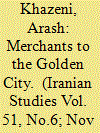| Srl | Item |
| 1 |
ID:
187542


|
|
|
|
|
| Summary/Abstract |
In the late nineteenth century, as world trade grew, figs grown along the Great Menderes Valley, Anatolia, became recognized globally for their taste. Aram Hamparzum, an Ottoman citizen of Armenian origin, contributed enormously to the figs’ prominence, by marketing them as ‘Smyrna Figs’ with the ‘Camel Brand’. Hamparzum, who also received the support of British trading houses, became known as the ‘fig king’ of the world markets, deeply impressing Western Anatolia’s producers and tradespeople with his methods, from processing to packaging. Using Turkish sources, this study focuses on Aram Hamparzum and his role in the fig market to analyze the influence of Ottoman non-Muslim subjects who directed the country’s foreign trade and the process of their withdrawal from the market and subsequent replacement by Turkish-Muslim traders. This change pushed the Izmir port to the background, and ‘Smyrna Figs’ was slowly forgotten as preference grew for cheaper figs from other countries.
|
|
|
|
|
|
|
|
|
|
|
|
|
|
|
|
| 2 |
ID:
162786


|
|
|
|
|
| Summary/Abstract |
This paper provides a translation and analysis of Sloane Mss. 3259 in the British Library, a Persian farmān from the court of King Chandrawizaya Rājā in the Arakanese Kingdom of Mrauk U (1429−1784). Written in 1728 and addressed to the Armenian merchant Khwājeh Georgin of the port of Chennaipattana across the Bay of Bengal in India, the decree is a permit for the lucrative trade in elephants and ivory from the forests of Arakan. The royal decree reveals the presence of Persian as a mutual language of encounter, exchange, diplomacy, and correspondence in eighteenth-century Southeast Asia. Through the manuscript, a view emerges of a sovereign forest kingdom of manifold rarities at the margins of the Persianate and Mughal worlds.
|
|
|
|
|
|
|
|
|
|
|
|
|
|
|
|